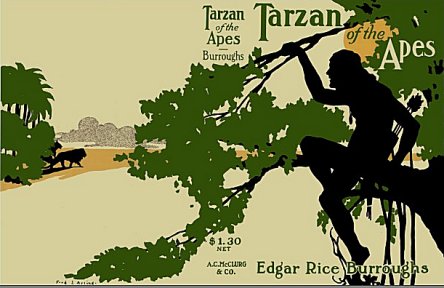 Tarzan is one of the most popular characters of the 20th
century to have leapt from the written page onto the silver screen. But
for many years the portrayal of Tarzan in the movies, following the first
sound production, was greatly at odds with the original literary form of
the character. Instead of a literate, well-spoken jungle adventurer, Tarzan
was portrayed as an illiterate character speaking in broken English, and
was at times was rendered a virtually non-speaking figure. In many ways
it was as if the character had struggled to find a voice when the transition
from the silent movies to the world of sound was made. Tarzan, the last
of the silent action heroes, who could shake the primordial forest with
his famous cry but struggled to utter a human word, had a long journey
to truly find his voice on the big screen.
Tarzan is one of the most popular characters of the 20th
century to have leapt from the written page onto the silver screen. But
for many years the portrayal of Tarzan in the movies, following the first
sound production, was greatly at odds with the original literary form of
the character. Instead of a literate, well-spoken jungle adventurer, Tarzan
was portrayed as an illiterate character speaking in broken English, and
was at times was rendered a virtually non-speaking figure. In many ways
it was as if the character had struggled to find a voice when the transition
from the silent movies to the world of sound was made. Tarzan, the last
of the silent action heroes, who could shake the primordial forest with
his famous cry but struggled to utter a human word, had a long journey
to truly find his voice on the big screen.
The Written Word
In 1914 a man had a vision to create a character that
would explore the influences of nature and nurture on the development of
the individual. As Edgar
Rice Burroughs sat down to write Tarzan
of the Apes (1914) and create his iconic ape man, he gave him
the genetics of an English nobleman and made his nursery the savage jungle.
Rather than his genteel biological parents he would be raised by savage
great apes. Burroughs said,
As I got into the story,
I realised that the logical results of this experiment must have been a
creature that would have failed to inspire the sympathy of the ordinary
reader, and that for fictional purposes I must give heredity some breaks
that my judgement assured me the facts would not have warranted. And so
Tarzan grew into a creature endowed with the best characteristics of the
human family from which he was descended and the best of those which mark
the wild beasts that were his only associates from infancy until
he had reached man's estate. (E. R. Burroughs,
The Tarzan Theme,
ERBzine
0058 ~ Also reprinted in Legends of Literature: The Best Articles,
Interviews and Essays from the Archives of Writers Digest Magazine, Writers
Digest Books, Cincinnati, 2007, pg 41-47)
One of the concessions that Burroughs made was placing within
his hero a intellect of genius proportions. It is this amazing mind, thirsty
for knowledge, which drives Tarzan into the abandoned jungle cabin of his
deceased human parents. It is here that he discovers the childrens picture
books intended for him if they had reached their intended destination.
Defying all developmental odds, Tarzan begins gazing at the pictures in
these books, eventually making connections between the pictures and the
words. After persevering for several years, Tarzan eventually teaches himself
to read and write, instilling with in him a sense that he is different
than his adopted anthropoid family. However he is unable to speak any language
other than that of the great ape species, having only been exposed to English
for the first year of his life.
This becomes a great plot device, with Tarzan able
to leave Jane written notes but unable to speak to her. This leads her
to believe that her handsome jungle man and Tarzan of the Apes were two
separate people, she in love with one and the other professing his love
in a note to her. Jane even leaves the jungle unaware that the object of
her affections is learning to speak French and eventually English at the
feet of a French naval officer, Lieutenant Paul D'Arnot. Barbara Creed,
in her article "Me Jane, You Tarzan," says,
Tarzan of the Apes was
born a gentleman; a factor which nothing could disguise and which bubbles
to the surface of his consciousness the minute he encounters a white woman.
But the thing which clearly sets him apart from the apes is his ability
to learn language.
(Barbara Creed, ME
JANE: YOU TARZAN!- A Case of Mistaken Identity in Paradise)
Creed sees the true hallmarks of Tarzan's noble ancestry
coming to flower upon his first meeting with Jane. But this noble ancestry
is made all the more potent, empowering and able to lift Tarzan from the
realm of the beasts, by his understanding of the written and spoken word.
By the time Tarzan arrives in civilisation he is ready to find his place
in the world of humanity. He is a self taught literate being, able to communicate
just as well in the House of Lords as in the company of the smallest jungle
monkeys. Along side of his superior physicality, this wide understanding
of language gives him mastery over whatever locale he finds himself in.
The Silent Screen
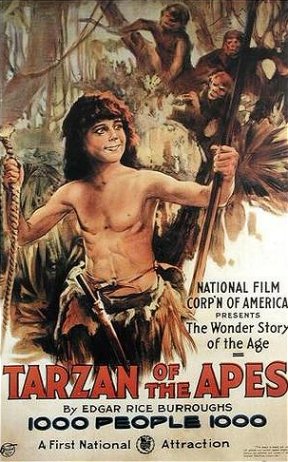
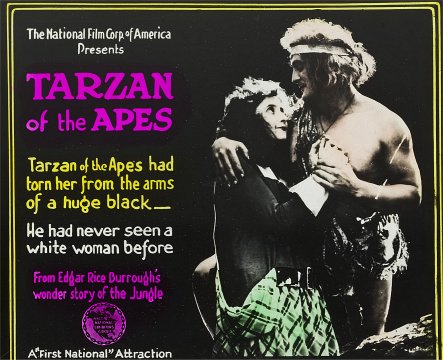 It's interesting that when Tarzan first came to the silver
screen in 1918 some of these plot devices were abandoned. In Tarzan
of the Apes (1918) the young Tarzan, played by Gordon Griffiths,
is taught to read from the books in the cabin and speak English by Binns,
a sailor who had helped his parents survive the mutiny that had left them
stranded in the jungle. In many ways Binns plays a similar role to D'Arnott
in the novel. He is the one who guides Tarzan from the ways of the beasts
to that of humanity. By the time the adult Tarzan (Elmo
Lincoln) meets Jane (Enid
Markey), he can fully communicate with her, simplifying for the screen
some of miscommunication and mistaken identity that works so well in the
novel. The Tarzan of the early cinema is a literate and verbal character
although, due to the cinematic technology of the time, a silent one.
It's interesting that when Tarzan first came to the silver
screen in 1918 some of these plot devices were abandoned. In Tarzan
of the Apes (1918) the young Tarzan, played by Gordon Griffiths,
is taught to read from the books in the cabin and speak English by Binns,
a sailor who had helped his parents survive the mutiny that had left them
stranded in the jungle. In many ways Binns plays a similar role to D'Arnott
in the novel. He is the one who guides Tarzan from the ways of the beasts
to that of humanity. By the time the adult Tarzan (Elmo
Lincoln) meets Jane (Enid
Markey), he can fully communicate with her, simplifying for the screen
some of miscommunication and mistaken identity that works so well in the
novel. The Tarzan of the early cinema is a literate and verbal character
although, due to the cinematic technology of the time, a silent one.
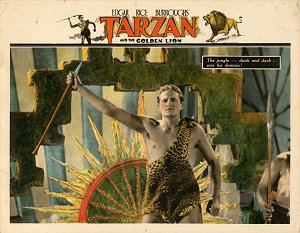
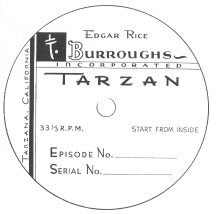
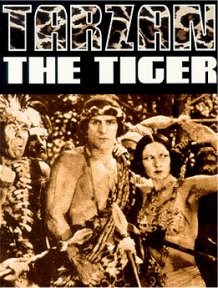 And so for the next eleven years and eight movies, Tarzan
swung through the world of silent cinema, literate, eloquent but virtually
unheard. One silent Tarzan, James
Pierce, star of Tarzan
and the Golden Lion (1927), did eventually get to give voice to
the character in the Tarzan
radio show (1932-1936) but never on the silver screen. 1929's Tarzan
the Tiger, the last of the silent productions starring Frank
Merrill, was a transitional movie that featured limited sound effects
which included the first depiction of the Tarzan
yell. Although very different than Merrill's, the next version
of this call would become arguably one of the most recognisable sound effects
in cinema history.
And so for the next eleven years and eight movies, Tarzan
swung through the world of silent cinema, literate, eloquent but virtually
unheard. One silent Tarzan, James
Pierce, star of Tarzan
and the Golden Lion (1927), did eventually get to give voice to
the character in the Tarzan
radio show (1932-1936) but never on the silver screen. 1929's Tarzan
the Tiger, the last of the silent productions starring Frank
Merrill, was a transitional movie that featured limited sound effects
which included the first depiction of the Tarzan
yell. Although very different than Merrill's, the next version
of this call would become arguably one of the most recognisable sound effects
in cinema history.
The Talkies
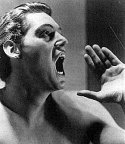 In
1932 MGM produced the first full sound version of Tarzan. The movie was
a loose adaption of Burroughs' novel and rather than telling the story
of Tarzan's childhood, began with a new story of Jane, her father, and
his partner Harry Holt, heading into the remote parts of the Dark Continent
in search of the elephant's graveyard. With no back story, Tarzan (Johnny
Weissmuller) arrives in the story fully grown. There is no account
of his self education or tutoring by marooned sailors. He is unfamiliar
with the language of humanity and in many ways still a silent action hero.
He is able to communicate with the beasts to great effect through the language
of the apes and the now famous version of the 'Tarzan
Yell' or 'the cry of a great bull ape (Tarzan
of the Apes, page 219)' as Burroughs originally called it.
However with English and the dialects of the native bearers he is ignorant.
In fact, in the scenario presented by Tarzan
the Ape Man (1932), it is Jane (Maureen
O'Sullivan) who becomes the bringer of human language to the Lord
of the Jungle.
In
1932 MGM produced the first full sound version of Tarzan. The movie was
a loose adaption of Burroughs' novel and rather than telling the story
of Tarzan's childhood, began with a new story of Jane, her father, and
his partner Harry Holt, heading into the remote parts of the Dark Continent
in search of the elephant's graveyard. With no back story, Tarzan (Johnny
Weissmuller) arrives in the story fully grown. There is no account
of his self education or tutoring by marooned sailors. He is unfamiliar
with the language of humanity and in many ways still a silent action hero.
He is able to communicate with the beasts to great effect through the language
of the apes and the now famous version of the 'Tarzan
Yell' or 'the cry of a great bull ape (Tarzan
of the Apes, page 219)' as Burroughs originally called it.
However with English and the dialects of the native bearers he is ignorant.
In fact, in the scenario presented by Tarzan
the Ape Man (1932), it is Jane (Maureen
O'Sullivan) who becomes the bringer of human language to the Lord
of the Jungle.
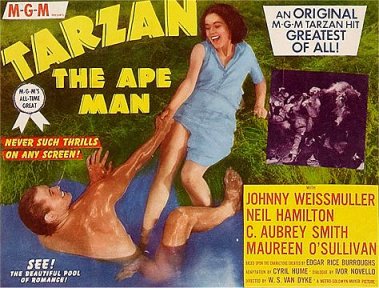 When
Tarzan first meets Jane, the window to his humanity begins to open. This
beast, that with a mighty yell could control the jungle, now childlike,
utters his first human words. The silent era left us with a Tarzan whose
'Victory Cry' broke, not just the quiet of the jungle, but the silence
of the medium itself. But it was the talkies that finally gave us a Tarzan
whose first struggling steps out of the silence of animal ignorance could
finally be heard. Both Barbara Creed and Frank McConell take note of the
importance that the element sound brings to cinematic portrayal of Tarzan's
first steps towards learning human language.
When
Tarzan first meets Jane, the window to his humanity begins to open. This
beast, that with a mighty yell could control the jungle, now childlike,
utters his first human words. The silent era left us with a Tarzan whose
'Victory Cry' broke, not just the quiet of the jungle, but the silence
of the medium itself. But it was the talkies that finally gave us a Tarzan
whose first struggling steps out of the silence of animal ignorance could
finally be heard. Both Barbara Creed and Frank McConell take note of the
importance that the element sound brings to cinematic portrayal of Tarzan's
first steps towards learning human language.
In his book, The Spoken Seen: Film & The Romantic
Imagination, Frank McConnell argues that this is why Johnny Weissmuller,
not Elmo Lincoln's silent Tarzan, has been remembered as 'the great type
of the role'. 'For Tarzan represents a victory over silence, a fundamentally
epistemological victory of the human mind over the mute universe of things,
the primal tropical jungle. And for the representation of that victory
the Tarzan films need sound. Weissmuller's famous guttural so like Karloff's
speech in The Bride - is among the most eloquent of screen utterances.'(Creed)
And so the Tarzan who educates himself in the written
word and who learns human speech at the feet of a male mentor is replaced
by the Tarzan who learns to speak upon his first meeting with a white,
and possibly any, human female, an exchange that has become inextricably
linked with the concept of the character in the popular consciousness.
Mythological Allusions
What makes this version of Tarzan's education all
the more powerful are the mythological parallels that can be can be found
with in it. Connections can be drawn with the story of the Garden of Eden
in the Hebrew Bible, in particularly Chapter 2, where God asks Adam to
find a suitable partner amongst the other beasts of creation. Thankfully
Adam is unable to find one and God is led to create woman, who for both
good and ill, leads Adam to make certain choices that lead to both expulsion
from simplicities of the garden paradise but also from ignorance
to an awareness of good and evil. In Jane, Tarzan meets "Bone of my
bones and flesh of my flesh" (Gen 2: 23 NRSV), a female of his own
kind that will lead him into complicated world of human interactions.
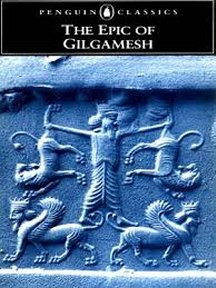 Connections
can also be drawn with the story of the wild man, Enkidu, found in the
ancient Sumerian The
Epic of Gilgamesh (Penguin Books, London, 1999). In this story,
the Gods decide to create an equal for the mighty and unrivalled Gilgamesh,
King of Uruk, in order to curtail his increasing tyranny. Like Adam in
the Garden of Eden, Enkidu is fashioned out of clay and becomes a feral
man who runs with the gazelle. He is described as 'Enkidu the hero, the
offspring of silence (The Epic of Gilgamesh, Tablet 1, verse 104)'
and he continues to live his savage life until he begins to cause problems
for local hunters. Soon a plan is hatched to tame the wild man and a prostitute
is sent to seduce him. After spending a week with her, he is unable to
return to the herd and for the first time in the narrative begins to speak.
The woman then convinces him to leave the wild for the company of people.
As in Tarzan the Ape
Man, it is contact with a human woman that initiates the wild man
into the world of humanity, from the world of silence into the world of
language, and eventually as the series progressed, into domesticity.
Connections
can also be drawn with the story of the wild man, Enkidu, found in the
ancient Sumerian The
Epic of Gilgamesh (Penguin Books, London, 1999). In this story,
the Gods decide to create an equal for the mighty and unrivalled Gilgamesh,
King of Uruk, in order to curtail his increasing tyranny. Like Adam in
the Garden of Eden, Enkidu is fashioned out of clay and becomes a feral
man who runs with the gazelle. He is described as 'Enkidu the hero, the
offspring of silence (The Epic of Gilgamesh, Tablet 1, verse 104)'
and he continues to live his savage life until he begins to cause problems
for local hunters. Soon a plan is hatched to tame the wild man and a prostitute
is sent to seduce him. After spending a week with her, he is unable to
return to the herd and for the first time in the narrative begins to speak.
The woman then convinces him to leave the wild for the company of people.
As in Tarzan the Ape
Man, it is contact with a human woman that initiates the wild man
into the world of humanity, from the world of silence into the world of
language, and eventually as the series progressed, into domesticity.
A Little Less Conversation, A Little
More Action
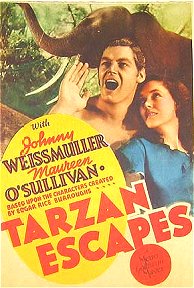
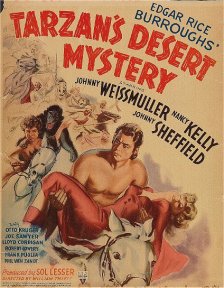 However as the MGM film series continued, Tarzan's abilities
to communicate with humanity continued to be limited. Unlike his eloquent
literary and silent counterparts, fluent speech and written word continued
to allude him. Jane, and soon his adopted son Boy, would frequently act
as Tarzan's guides to the ways of civilization. Jane would act as intermediary
when outsiders would visit (i.e. Tarzan
Escapes (1936) and Boy would read Jane's letters when she was away
in England (i.e. Tarzan's
Desert Mystery (1943). In fact in some independent productions
of the period, [Tarzan
the Fearless (1933),
Tarzan's
Revenge (1938), and later MGM's own remake of Tarzan
the Ape Man (1959)], Tarzan is rendered virtually mute once again,
allowing he and the female lead to present a new version of his first spoken
human words and the following romance.
However as the MGM film series continued, Tarzan's abilities
to communicate with humanity continued to be limited. Unlike his eloquent
literary and silent counterparts, fluent speech and written word continued
to allude him. Jane, and soon his adopted son Boy, would frequently act
as Tarzan's guides to the ways of civilization. Jane would act as intermediary
when outsiders would visit (i.e. Tarzan
Escapes (1936) and Boy would read Jane's letters when she was away
in England (i.e. Tarzan's
Desert Mystery (1943). In fact in some independent productions
of the period, [Tarzan
the Fearless (1933),
Tarzan's
Revenge (1938), and later MGM's own remake of Tarzan
the Ape Man (1959)], Tarzan is rendered virtually mute once again,
allowing he and the female lead to present a new version of his first spoken
human words and the following romance.
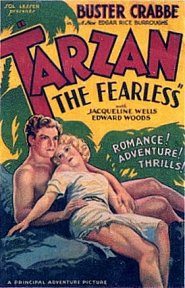
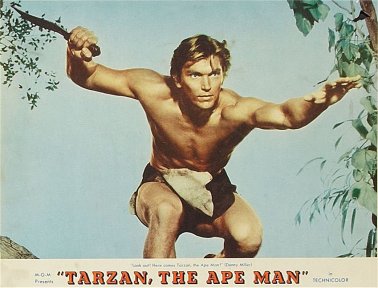
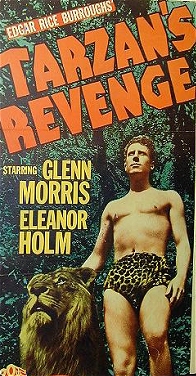
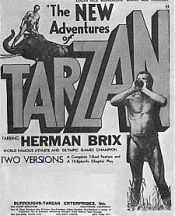 Only
one production, Edgar Rice Burroughs' own, The
New Adventures of Tarzan (1933), presented an eloquent, educated
Tarzan. This movie serial, and its two feature adaptations, was Burroughs'
own response to the treatment of his character by MGM and its imitators.
It presented an ape man closer to the way he had conceived him, speaking
fluent English, equally at home being John Clayton, Lord Greystoke, as
he was being the Lord of the Jungle. In many ways this film was more instep
with the productions of the silent era in it's portrayal of the Ape Man
and demonstrates the direction the creator of the character wished the
other studios had taken. However, despite its literary authenticity, this
production failed to have an impact on the portrayal of the character in
the mainstream of Tarzan films. This may be in part due to the fact that
it was felt that cinematically Tarzan worked best in a primitive jungle
setting and to civilise his character too much might jeopardise this.
Only
one production, Edgar Rice Burroughs' own, The
New Adventures of Tarzan (1933), presented an eloquent, educated
Tarzan. This movie serial, and its two feature adaptations, was Burroughs'
own response to the treatment of his character by MGM and its imitators.
It presented an ape man closer to the way he had conceived him, speaking
fluent English, equally at home being John Clayton, Lord Greystoke, as
he was being the Lord of the Jungle. In many ways this film was more instep
with the productions of the silent era in it's portrayal of the Ape Man
and demonstrates the direction the creator of the character wished the
other studios had taken. However, despite its literary authenticity, this
production failed to have an impact on the portrayal of the character in
the mainstream of Tarzan films. This may be in part due to the fact that
it was felt that cinematically Tarzan worked best in a primitive jungle
setting and to civilise his character too much might jeopardise this.
This may have seemed to be the lesson learned from the
second silent Tarzan feature, The
Romance of Tarzan, which saw much of the film take place out side
of Africa in the USA. The Romance of Tarzan, after the massive box
office success of Tarzan of the Apes, was a disappointment for the
studio when it only managed to break even. Of this film, its star Elmo
Lincoln said, "They made a mistake when they put Tarzan in clothes. Tarzan
is a wild man and he does not belong in a drawing room (ERBzine)."
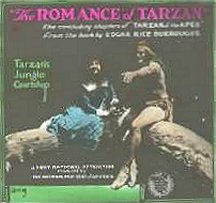
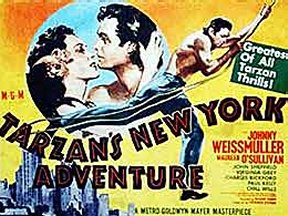
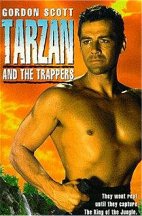 When Tarzan first donned clothes and left the jungle in the
MGM's Tarzan's New York
Adventure (1942) it wasn't to claim his birth right as Lord Greystoke,
but to present him in a fish-out-of-water tale, as he and Jane, his continuing
bridge to the world of human communication, seek to rescue Boy from the
hands of unscrupulous circus operators. While Jane tries to solve the problem
through the verbal and written world of the legal system, Tarzan,
a man of few words, solves the problem with a stampede of circus elephants.
When Tarzan first donned clothes and left the jungle in the
MGM's Tarzan's New York
Adventure (1942) it wasn't to claim his birth right as Lord Greystoke,
but to present him in a fish-out-of-water tale, as he and Jane, his continuing
bridge to the world of human communication, seek to rescue Boy from the
hands of unscrupulous circus operators. While Jane tries to solve the problem
through the verbal and written world of the legal system, Tarzan,
a man of few words, solves the problem with a stampede of circus elephants.
Tarzan was still very much a character with his feet still
firmly planted in the silent era. He was a visual character of action whose
most powerful form of communication was a yell that, although paradoxically
first heard in the silent era, was just as much a mimed visual performance
as it was a dubbed sound effect. With his hands cupped around his mouth
and his head thrown back, the audience needed no sound to understand what
Tarzan was doing.
This philosophy of action over words, both written and
spoken, is beautifully highlighted in a passage of dialogue from 1958s
Tarzan and the Trappers.
The interchange between Tarzan and Jane takes place following a reading
lesson that Jane had been having with Boy, now also called Tartu.
Tarzan: Books little
value in jungle, what man does more important than what man read or say.
Jane: You taught me that
Tarzan, but you should learn to….
Tarzan: I learn.
Unlike Burroughs' original character,
that pushed himself headlong into understanding the written and spoken
language of his own kind, the Tarzan of the talkie era chose to procrastinate
in doing so. In the series started by MGM and it's imitators, Tarzan was
Lord of the Jungle, words were for woman, children and lesser men of the
civilised world. None of them could make the jungle quake or defeat villains
in the heart of civilization with only a single cry.
Tarzan Speaks
However, by the mid-1950s things were beginning to change
for the Tarzan film series and Tarzan's words, "I learn", would prove to
be prophetic. In Tarzan's
Hidden Jungle (1955) and Tarzan
and the Lost Safari(1957), Tarzan appeared for the first time,
since Burroughs' New Adventures, without either Boy or Jane (or
romantic equivalent). Besides three throwbacks to the Weissmuller formula,
Tarzan's
Fight for Life (1958 ) and
Tarzan
and the Trappers (1958), both connected with a failed attempt to
bring Tarzan to TV, and the remake Tarzan the Ape Man (1959), Tarzan
(Gordon Scott) was now a lone adventurer in the jungles of darkest Africa
with out a family in tow.
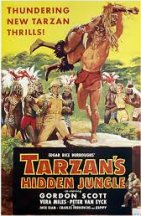
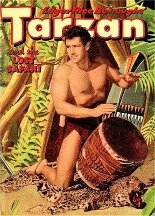
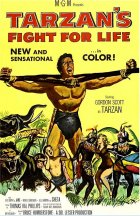
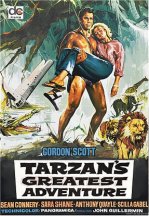 This move to shift Tarzan away from the family settings established
in the films was an important one if the series was to have a future. Of
this situation Nicholas Anez said, "The increased emphasis on Tarzan's
domesticity as husband, father and owner of a cute pet had emasculated
him." (Tarzan's
Greatest Adventure, Films in Review, Issue Unknown).
This move to shift Tarzan away from the family settings established
in the films was an important one if the series was to have a future. Of
this situation Nicholas Anez said, "The increased emphasis on Tarzan's
domesticity as husband, father and owner of a cute pet had emasculated
him." (Tarzan's
Greatest Adventure, Films in Review, Issue Unknown).
However the greatest shift in the presentation of the
character came in 1959 when Tarzan's promise to "learn" was fulfilled.
In the face of a failed TV show, falling box office takings, a changing
society and a new production company, Tarzan had to learn some new tricks
(Anez). In 1959 the Tarzan of the cinema finally entered the sound era
completely, finally learning to speak fluent English in Tarzan's
Greatest Adventure (1959). This took some by surprise, who assumed
that the non-verbal ape man characterization had its origins in Burroughs'
stories.
The Variety review for Tarzan's Greatest Adventure
stated "Tarzan (Gordon Scott) is a modern he-man, still adorned in loin
cloth but more conversational than Edgar Rice Burroughs pictured him."
(Variety Movie Guide 97, Hamlin, London, 1996, pg 933). Finally the Lord
of the Jungle was being portrayed as a literate, eloquent, if not reserved,
hero who could read and write. The '60s and '70s cinematic, and soon television,
Tarzan was a hero closer to Burroughs' original vision.
Tarzan now could not only communicate with the beasts,
but could communicate with people all over the globe, even leaving Africa
in suit and tie to fight jungle evil in Asia and South America. He was
the ape man who had left his savage home to be educated and who had returned
to protect it from oppression, exploitation and to aid the cause of modern
progress when appropriate. It was Tarzan who now taught his adopted son
to read and who negotiated between the people of the jungle and the intrusion
of civilization. This was a Tarzan, not just of the age of sound, who finally
had a voice which was complete and unbroken, but a figure of the modern
era who, like Burroughs envisioned, could be a Lord, not just in the jungle,
but in the world of men.
The Legacy
In 1971 the lights came down on the series of 'talkie'
Tarzan movies begun by MGM in 1932. Tarzan
and the Perils of Charity Jones, originally a two part episode
of the 1966-67 TV series, presented a very different character than had
first appeared in the 1930s. Finally the cinematic portrayal of Tarzan
had caught up with its literary counterpart. However, after nearly 40 years,
it appeared as if the series had finally run out of steam. Although unauthorised
productions such as the Spanish produced
Tarzan
and the Brown Prince (1972) would appear, it would be a decade
before another authorised live action Tarzan feature would surface.
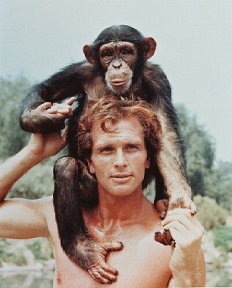
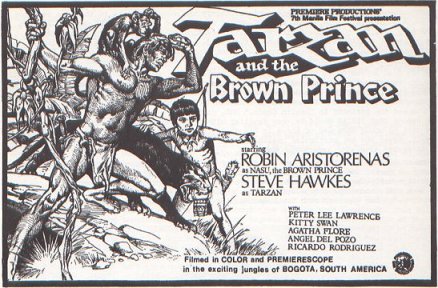
Since then, the release of new Tarzan productions on both
the small and big screen has been idiosyncratic and spasmodic. With in
these productions the portrayal of the character has oscillated between
the non-verbal approach established by Weissmuller (i.e. Tarzan
the Apeman (1981), Tarzan (1991-1994) and the more well
spoken character (i.e. Greystoke; The Legend of Tarzan (1984), Tarzan
and the Lost City (1998).
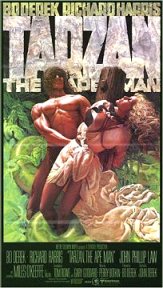

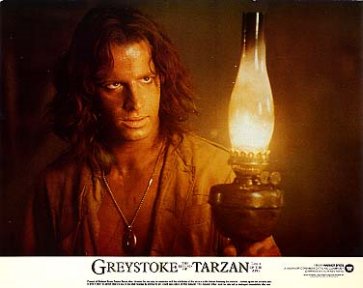
However when all the portrayals of the last 30 years are
compared, it appears on the weight of it, that the eloquent Tarzan is winning.
Finally the Lord of the Jungle has unchained himself from the shackles
of the silent era and has ridden Tantor into the world of human language,
a Tantor who still comes when he gives his mighty, savage call.







 In
1932 MGM produced the first full sound version of Tarzan. The movie was
a loose adaption of Burroughs' novel and rather than telling the story
of Tarzan's childhood, began with a new story of Jane, her father, and
his partner Harry Holt, heading into the remote parts of the Dark Continent
in search of the elephant's graveyard. With no back story, Tarzan (Johnny
Weissmuller) arrives in the story fully grown. There is no account
of his self education or tutoring by marooned sailors. He is unfamiliar
with the language of humanity and in many ways still a silent action hero.
He is able to communicate with the beasts to great effect through the language
of the apes and the now famous version of the 'Tarzan
Yell' or 'the cry of a great bull ape (Tarzan
of the Apes, page 219)' as Burroughs originally called it.
However with English and the dialects of the native bearers he is ignorant.
In fact, in the scenario presented by Tarzan
the Ape Man (1932), it is Jane (Maureen
O'Sullivan) who becomes the bringer of human language to the Lord
of the Jungle.
In
1932 MGM produced the first full sound version of Tarzan. The movie was
a loose adaption of Burroughs' novel and rather than telling the story
of Tarzan's childhood, began with a new story of Jane, her father, and
his partner Harry Holt, heading into the remote parts of the Dark Continent
in search of the elephant's graveyard. With no back story, Tarzan (Johnny
Weissmuller) arrives in the story fully grown. There is no account
of his self education or tutoring by marooned sailors. He is unfamiliar
with the language of humanity and in many ways still a silent action hero.
He is able to communicate with the beasts to great effect through the language
of the apes and the now famous version of the 'Tarzan
Yell' or 'the cry of a great bull ape (Tarzan
of the Apes, page 219)' as Burroughs originally called it.
However with English and the dialects of the native bearers he is ignorant.
In fact, in the scenario presented by Tarzan
the Ape Man (1932), it is Jane (Maureen
O'Sullivan) who becomes the bringer of human language to the Lord
of the Jungle.





















